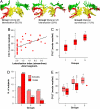Symmetries in human brain language pathways correlate with verbal recall
- PMID: 17939998
- PMCID: PMC2040413
- DOI: 10.1073/pnas.0702116104
Symmetries in human brain language pathways correlate with verbal recall
Abstract
Lateralization of language to the left hemisphere is considered a key aspect of human brain organization. We used diffusion tensor MRI to perform in vivo virtual dissection of language pathways to assess the relationship between brain asymmetry and cognitive performance in the normal population. Our findings suggest interhemispheric differences in direct connections between Broca's and Wernicke's territories, with extreme leftward lateralization in more than half of the subjects and bilateral symmetrical distribution in only 17.5% of the subjects. Importantly, individuals with more symmetric patterns of connections are better overall at remembering words using semantic association. Moreover, preliminary analysis suggests females are more likely to have a symmetrical pattern of connections. These findings suggest that the degree of lateralization of perisylvian pathways is heterogeneous in the normal population and, paradoxically, bilateral representation, not extreme lateralization, might ultimately be advantageous for specific cognitive functions.
Conflict of interest statement
The authors declare no conflict of interest.
Figures


References
-
- Geschwind N, Galaburda AM. Arch Neurol. 1985;42:428–459. - PubMed
-
- Gannon PJ, Holloway RL, Broadfield DC, Braun AR. Science. 1998;279:220–222. - PubMed
-
- Nottebohm F. Science. 1970;167:950–956. - PubMed
-
- Geschwind N, Levitsky W. Science. 1968;161:186–187. - PubMed
-
- Damasio H, Damasio A. In: Principles of Behavioural and Cognitive Neurology. Mesulam M, editor. New York: Oxford Univ Press; 2000. pp. 294–315.
Publication types
MeSH terms
Grants and funding
LinkOut - more resources
Full Text Sources

